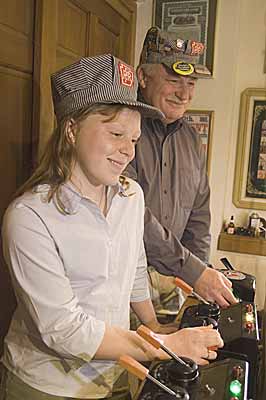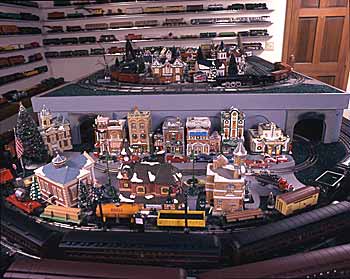A Family Together Feature
All Aboard the April Express
By Kathy Vilim DaGroomes
Photographs by Jim Sugar
The classic era of passenger trains and Pullman cars thrives in the model-train world of one California Scouting family.
- "A Family Together" from previous issues
- Museums Help Scouts Learn About Railroading, Earn the Merit Badge
Unlike most homeowners, one of the first things a model railroader thinks about when looking for a new house is the space available for a train layout.
For the family of Scouter and longtime model railroader John April of Orinda, Calif., that consideration was made easier when they were looking for their current home because John's wife of 40 years, Judy, is a real estate agent. She knows houses, and she knows John.
"When I saw the house and that room downstairs with a separate entrance," Judy said, "I bought it that night—specifically for his trains."
How many trains does John own? "I guess I have somewhere between tens and hundreds of sets," the railroad enthusiast estimated.
And his collection may never stop growing. According to fellow Scouter and model railroader David Pfeifer: "John will say, 'I think I have completed my collection of trains.' But then he will add: 'There is just one more train I'd like to find.'"
No visitor, in fact, can walk into the Aprils' house without experiencing the joy of the John April Express.
There's that room with the separate entrance, now officially "the train room." Colorful antique toy trains line the walls that surround the large train layout and miniature Snow Village in the middle of the floor. A poster-size train schedule from nearly 100 years ago, stock certificates from long-defunct railroads, and other pieces of memorabilia recall a distant time when the steam locomotive ruled the landscape and helped forge a nation.
A boy and his train
"Johnny" April got his first toy train engine as a 9-year-old in St. Louis, Mo., in the early 1950's. The engine was ordered as a Christmas gift but didn't arrive until March. The wait apparently didn't dampen his enthusiasm for toy trains.
In fact, each Christmas after that, he asked for different train cars, patiently building his set one piece at a time. Johnny even convinced his little brother, Tom, to also ask for a train set one Christmas so that it could be joined into John's "train empire."
 Shelby and Grandpa John run seven trains at once on the layout—with no accidents. |
In addition to his American Flyer toy train, Johnny April had two other things that were important to him at the time: his bicycle and his Cub Scout den. "Mom was my den mother, and my best friends were in the den," he recalled.
Although John's bike may not be as important today, Scouting and trains still are: He rides the commuter train for an hour each weekday to and from work in San Francisco; and as a Scouting volunteer, he is vice president of operations for the Mount Diablo Silverado Council in Pleasant Hill, Calif. In years past, he has been a den leader and troop committee co-chair, as well as the council's vice president for finance.
John April's model railroading hobby has also gathered steam since his childhood, drawing in his entire family—wife, children, grandchildren, sister, brother-in-law—plus friends and associates. John's love of toy trains, real trains, railroads, railroad museums, and all things railroading, is infectious.
Recalling her father's train room in their house in St. Louis while she was growing up, daughter Mary April, a professional Scouter, said: "My father took over our whole basement with his train layout, and it was wonderful."
Mary, the oldest of John and Judy's four grown children (the others are Eagle Scouts John III, Mark, and Paul), remembers her father "creating fun new layouts with the track and new tunnels for the trains to go under."
"He let us use all his trains; he was very generous. I just remember we had the best talks when we were playing with the trains."
'One of the greatest hobbies'
Everybody in John's family—immediate or extended—has his or her own train engine, and probably more than one, provided by John. Every nephew, cousin, sister, relative, friend, or soon-to-be friend will eventually be gifted by John with some type of toy train.
 The Aprils' Snow Village train layout depicts an evening during the winter holidays in a Midwestern town; but holidays or not, the freight trains keep running on this railroad. |
Fellow train enthusiast David Pfeifer explained his good friend's feelings about model railroading: "Something John has voiced over the years is that model railroading is one of the greatest hobbies for a youngster. He says they can learn [so much]: the collecting of old and antique model trains; the mechanics incorporated into the design of the various engines and cars; the architectural design of a town in a layout.
"Also, the geometry of the track so it will fit a layout and the trains will run; the electronics and repair; the art form of creating bridges, buildings, and scenery; and finally, the history of the toy train hobby and of the big railroads—the fun of knowing how railroads played a vital role in the development of the U.S. and other parts of the world."
John has seen to it that all his grandchildren have been duly introduced to his hobby. For instance, John III loved toy "twains" when he was little; so when his son, John IV, turned 3 not long ago, Grandpa John gave him a train engine.
John has also gifted daughter Mary's two children, Henry Brunner, 10, and Shelby Brunner, 13, with several train engines. The two can often be found in their grandfather's train room, running their locomotives. Grandson Henry, like John and Judy's youngest son, Paul, is interested in collecting. "There are some really old trains available, and it's fun to collect them," said Henry.
'Preserving part of childhood'
Webelos Scout Henry also lends a hand to his grandfather in John's duties as a Railroading merit badge counselor. To date, John has probably given his Railroading class to nearly a thousand boys who have earned the badge, instructing 10 Boy Scouts per session.
Another element of John and Judy's support of Scouting is their efforts in fund-raising. The two participate in auctions benefiting the Mount Diablo Silverado Council, often donating railroading-related items. Judy annually plans one recurring auction item: a model railroading-themed luncheon at the Aprils' home. The event includes a lunch fit for the chairman of a rail line, followed by a trip down to the train room so that everybody present can run John's and others' toy trains all afternoon.
John's son Paul has been instrumental in helping his dad keep an inventory of the antique train collection. Paul also has been resourceful in aiding his father's search for that elusive "one more train car" that will complete an antique set lacking a caboose or boxcar.
Paul is quick to point out, though, that the hobby of model railroading is not about turning a profit by enhancing or eventually selling a valuable collection as much as it is about relationships between people.
"Model railroading is about preserving part of your childhood, as well as passing along this hobby to future generations," said Paul. "The hobby has been a rewarding one for me because it has brought the family together.
"We did a lot of trips to different [railroad] museums. And for Christmas, we always had the train around the tree, and so that time of year was kind of magical," said Paul. "I also remember being 8 years old and walking hand in hand with my father into those large train meets where people talked model railroading and also were buying and selling trains and accessories. I was impressed by that from an early age."
Mary's daughter, Shelby, described her family's hobby of model railroading in this way: "You don't really outgrow it...if you love it and your family loves it, too. It helps bring the family together a lot. The family brings its memories together with the trains."
John recalls one train story that is surely a memory for Judy.
"One time when we went to Colorado," said John, "we finished up with a customer luncheon at 3 p.m., and I wanted to drive all the way to Durango that night so I could ride the [Durango & Silverton Narrow Gauge Railroad] the next morning. And we went. We didn't get to the motel until 1 o'clock in the morning, and the next day we rode the train.
"You gotta know Judy's a great gal, and she's understanding and patient with me—although she does think I have enough trains."
Kathy Vilim DaGroomes is associate editor of Scouting magazine.
Museums Help Scouts Learn About Railroading, Earn the Merit BadgeMany railroad museums in the United States enable Cub Scouts and Boy Scouts to learn about trains and the history of the great railroads that linked the East and West Coasts of the United States after the 1860's. Some offer programs to instruct Scouts in the Railroading merit badge and provide opportunities for Eagle Scout leadership service projects. Scouter Jay Oakman of the Mid-America Council in Omaha still remembers his first experience with a railroad. "It was humongous," said Oakman, manager of property description for the Union Pacific Railroad. "I can remember the steam, my first visit to the Oakland terminal in Oakland, Calif.; and I got to watch this steam engine come into the station, and it stopped. It seemed as if it took me a whole day to walk from one end of that [train] to the other." Oakman, a Scouting volunteer for 25 years, has mainly been involved with Cub Scouting. Currently, he is a pack trainer. It isn't hard for him to imagine how entertaining it would be for Cub Scouts to visit a railroad museum. "It would be a great deal of fun, because not only would you be able to walk around an engine and the railroad cars, but you [might] actually be able to sleep on one of the cars or sleep on the engine itself." Here are two railroad museums with specific activities for Scouts:
The National Railroad Museum. Featured among the museum's must-see exhibits are "Big Boy," the world's largest steam locomotive, and the "Dwight D. Eisenhower," a British locomotive named to honor the late president and American general for his role as supreme commander of the Allied Forces during World War II. Information concerning hours, admission rates, and special events can be obtained at the museum's Web site, www.nationalrrmuseum.org or by calling (920) 437-7623.
The Galveston Railroad Museum. Boy Scouts may take advantage of the facilities to study for the Railroading merit badge under longtime instructor Don Harper. In the yard are diesel and steam engines, freight and passenger cars, and cabooses. Possibilities for Eagle Scout service projects are available as well. For more information, visit the museum's Web site at www.galvestonrrmuseum.com, send an e-mail to galvrrmuseum@sbcglobal.net, or call (409) 765-5700. For more railroad museums, visit these Web sites: www.railsusa.com/links/Railroad_Museums/ and www.railmuseums.com. —K.V.D. |
October 2006 Table of Contents
Copyright © 2006 by the Boy Scouts of America. All rights thereunder reserved; anything appearing in Scouting magazine or on its Web site may not be reprinted either wholly or in part without written permission. Because of freedom given authors, opinions may not reflect official concurrence.